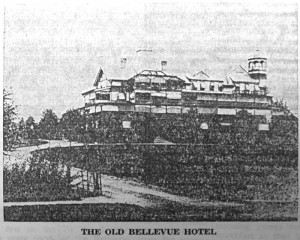The dining room of the old Bellevue Hotel, that hostelry so famous in Wayne in the last two decades of the 19th century, was a spacious room in the center of the building. Its wide doorway was at the end of the hallway that led from the main entrance, which faced on Lancaster Pike.
From its windows, looking to the East and to the West, guests could see spacious, well-kept lawns, flower gardens, shrubbery and trees. There were several good tennis courts on both sides of the building and space for that other, if less strenuous game, croquet, so popular among young and old alike at that time.
Saturday nights were gay times at the hotel, with “hops” held each week in this big dining room. These were for the “dowager mamas” who sat chatting throughout the evening as they watched the young people dance by.
These hops were mainly for the guests of the hotel, although a few cards for outsiders were issued through the office. From 8:30 until 11:30 the small orchestra played waltz and two-step music. But promptly at 11:30 the party stopped, and by 11:50 guests who were Philadelphia bound were at the railroad station to catch the last train.
Twice during the summer “Germans” were given. They were very formal affairs with the girls in their most beautiful evening dresses and the men in their “tall coats”. Favors were in the form of small silver trinkets. And since these were very special occasions, punch was always served.
The “Mikado” parties were events long to be remembered in the annals of the Bellevue. Two of Dr. Arms’ pictures show the women guests of the hotel grouped on the porch, all of them dressed in handsome figured kimonos tied around the waist with wide sashes, each with her fan and paper parasol. Their hair is dressed in true Japanese fashion and ornamented with large pins. A great deal of time and money was spent on their costumes, according to Mrs. Davis, who adds that “the women looked very beautiful”.
But the Fourth of July celebration was the really grand one of the gay summer, for which plans were made long in advance. There were many sports events for all of which prizes were given. in the morning the potato races, bicycle races, and competitive games of quoits and croquet took place. In the afternoon came the big baseball game, guests versus the waiters, always a jolly event.
At one o’clock dinner was served. Again we could wish that some of the menus might have been kept. The menu cards themselves, Mrs. Davis describes as “specially embossed” and listing “the finest foods and delicacies”. Many guests always kept their private supplies of wine and champagne on their porches, and for this big event of the summer they drew on these supplies. For old and young alike souvenirs were provided. in the evening there was always a more than usually pretentious hop with a large orchestra to furnish the music. And last but not least, there were Fourth of July fireworks.
Part of the hotel was partitioned off in winter to keep the rest of it warmer and more cozy than it might otherwise have been. Ordinarily there were about 50 guests staying there during the cold months. one season the most distinguished early winter guest was Frances Hodgson Burnett, author of “Little Lord Fauntleroy”.
At that time she wanted to be near Philadelphia long enough to consult Dr. Solis Cohen, a famous throat specialist, before she set sail for England. However, it was a trip she was not destined to take, for Dr. Cohen advised her that Lionel, her elder son, was too ill with tuberculosis to stand the voyage. In addition to Lionel she had a younger son, Vivian, with her at the Bellevue. Vivian was the hero of “Little Lord Fauntleroy”, Mrs. Burnett’s well-known book.
While the children evidently were not in the forefront of life at the Bellevue, there were always large numbers of them there with the parents at all times. One of Dr. Arms’ pictures shows a large group of these youngsters of the 80’s or 90’s. The girls all have long straight bangs hanging almost to their eyebrows and pigtails in the back, except for two more frivolous ones whose bangs are curled, with their hair hanging loose over their shoulders. The girls and younger boys all wear long dark stockings and high buttoned shoes. The younger boys are in tight knee length trousers with jackets buttoning straight up the front to the line of their collars.
The older boys are similarly dressed except that their trousers are long tight ones. Three of the more unconventional lads have discarded their jackets and have loose low collars, in contrast to the high starched ones on many of their companions. For the most part the girls are dressed in rather shapeless plaid gingham dresses with skirts half way to their shoe tops, though a few are dressed up for the occasion in what was then known as “all over embroidery”. The nurses are in neat uniforms with white aprons. Seated among the other small girls on the lowest step of the porch is a dark haired, bright eyed youngster easily recognizable as Mrs. Davis, then small Mary Arms, who has given your columnist the material for this story of the old Bellevue Hotel.
(To be continued)

